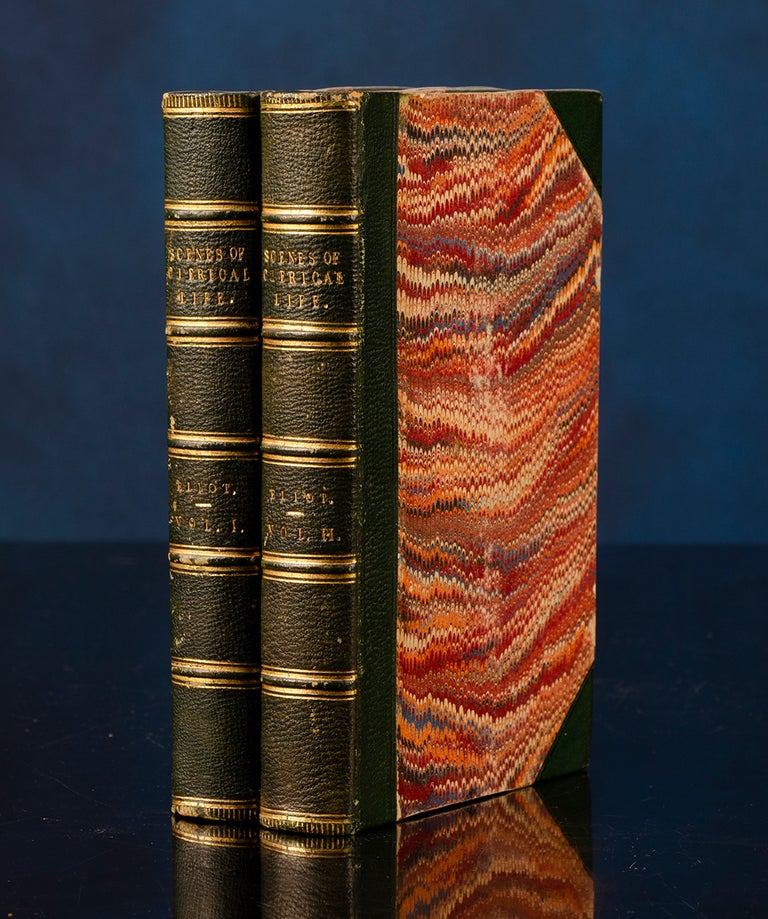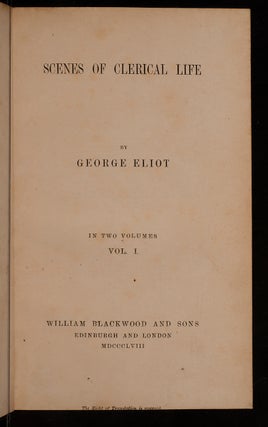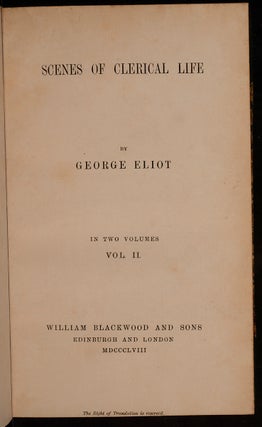Scenes of Clerical Life
Edinburgh: William Blackwood and Sons, 1858. Item #00003
Domestic Realism, Pathos, and Humor
George Eliot’s First Works of Fiction
ELIOT, George. Scenes of Clerical Life. In Two Volumes. Edinburgh: William Blackwood and Sons, 1858.
First edition in book form of George Eliot’s first works of fiction.
Two octavo volumes (7 3/8 x 4 5/8 inches; 187 x 117 mm.). [4], 366; [2], 381, [1, blank] pp. Bound without the half-title in Volume I and without the half-title and fly-title in Volume II.
Bound ca. 1858 in half dark green hard-grain morocco, ruled in blind, over marbled boards. Spines ruled and lettered in gilt in compartments. Marbled edges and endpapers. Scattered light foxing and soiling. Marginal paper-flaw to leaf H6 (pp. 123/124) of volume 1 (not affecting text). An excellent set of this rather scarce title.
Scenes of Clerical Life is the title under which George Eliot's first published fictional work, a collection of three short stories “The Sad Fortunes of the Reverend Amos Barton,” “Mr Gilfil’s Love-Story,” and “Janet’s Repentance,” was released in book form; it was the first of her works to be released under her famous pseudonym.
The stories were first published in Blackwood's Magazine over the course of the year 1857, initially anonymously, before being released as a two-volume set by Blackwood and Sons in January 1858. The three stories are set during the last twenty years of the eighteenth century and the first half of the nineteenth century over a fifty year period and take place in and around the fictional town of Milby in the English Midlands. Each of the Scenes concerns a different Anglican clergyman, but is not necessarily centered upon him. Eliot examines, among other things, the effects of religious reform and the tension between the Established and the Dissenting Churches on the clergymen and their congregations, and draws attention to various social issues, such as poverty, alcoholism, and domestic violence.
“These at once attracted praise for their domestic realism, pathos, and humour, and speculation about the identity of ‘George Eliot’, who was widely supposed to be a clergyman or possibly a clergyman’s wife" (The Oxford Companion to English Literature).
Baker & Ross A3.2. Parrish, p. 7. Sadleir 818. Wolff 2062.
Price: $2,450.00

 I have been in the rare and antiquarian book business for over forty years; my family has been in the rare books business since 1876. Rare books are in my blood.
I have been in the rare and antiquarian book business for over forty years; my family has been in the rare books business since 1876. Rare books are in my blood.


